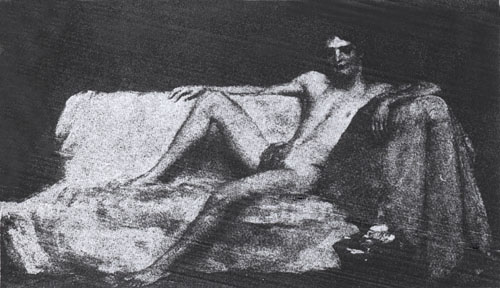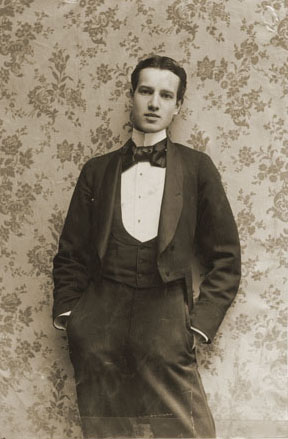
How does one learn who among people who lived long ago was gay? That investigating our history, determining who in the past was queer is hardly an easy matter, is at least one way in which gay may be legitimately regarded as the 'new black.'
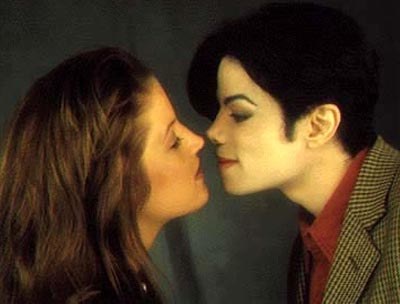
The King of Pop's tragic end, and cynical-seeming nuptials, each offer a cautionary tale of epic proportions. Yet Michael Jackson's example of so much needless misery is unlikely to end the old fashioned kind of 'gay marriage'. Homosexuals and lesbians will still sometimes wed straight spouses they can't love. Their suffering will prove no more of a disincentive to those desperate to appear 'normal,' than Bernard Madoff's isolated prosecution and unforgiving sentence are inclined to deter the unbridled greed that leads to widespread, monumental, and unregulated theft.
"It was very tempting, and everyone urged me to do it," says a wonderful friend who is a prominent decorator, "but ultimately, I resisted and didn't change my name or get married either. Me, with a properly waspy name like 'Sterling Bradford Perkins' and married, to a woman: imagine what a mistake that could have been!"
Of a certain age, my friend maintains that 'conforming' as family and associates pressured him to, would have meant hundreds of thousands of dollars in lost income from potential clients who had actively shunned him.
"They adored the look I was known for, decorous and aristocratic, while fun and colorful; but found me unattractively "ethnic", solely because of my name, mind you, and too outré, because I was queer."
'How had they known you were gay,' I asked?
"Well, except for a couple of the husbands; as cute as the dickens and very butch my dear, naturally, flattered by their attentions, I slept with those men, but otherwise people didn't know, not really, not apart from tittle-tattle. And so long as one 'toed the line' and got married, as they all had, as often as one wished, they didn't really care either. Irrespective of what that bunch did, of course one exhibited the proper discretion, one 'behaved', naturally. But oh, it was the original 'don't ask, don't tell,' you know, when I was young. Back then, this town was an absolute hive of hypocrisy."
In New York, where the practice of advantageous alliances of one sort and another is as old as the city, perhaps the most spectacular lavender marriage ever, occurred at Saint Patrick's Cathedral, in 1901. 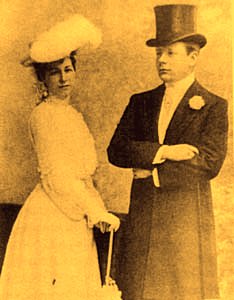
Heiresses, Elizabeth Drexel and her sister Lucy had earlier married the Dahlgren brothers. Their father was J. P. Morgan's partner. Still attractive and young when widowed with a son in 1898, lonely
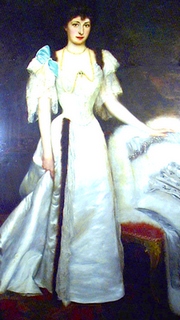
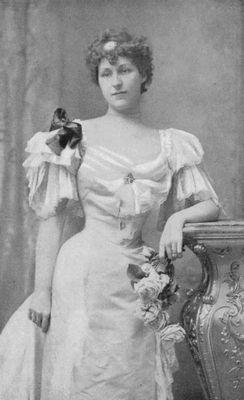
1894, 1899
"Bessie" was instantaneously captivated when Edith Gould introduced her to amusing Harry Symes Lehr. 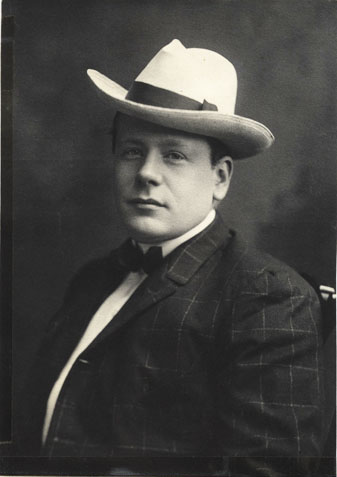 Tactful, but entertaining, the bachelor from Baltimore had a decided flair for drawing out unsuspected talents or any mild irreverence latent in others. Son of a once-well-off tobacco importer, like fellow southerner Ward McAllister he had assiduously made entertaining rich people and identifying what was fashionable or not, into his entire career.
Tactful, but entertaining, the bachelor from Baltimore had a decided flair for drawing out unsuspected talents or any mild irreverence latent in others. Son of a once-well-off tobacco importer, like fellow southerner Ward McAllister he had assiduously made entertaining rich people and identifying what was fashionable or not, into his entire career.
Not just any old millionaires either were the beneficiaries of Harry Lehr's charming singing, skilled piano playing, faultless tastes, shrewd advice, incessant drolleries and talent for taking feminine roles at amateur theatricals.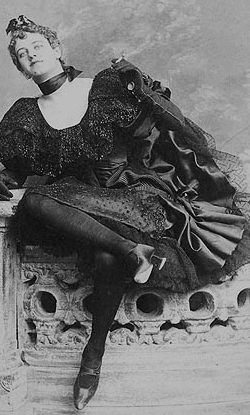 Harry's patrons and 'friends' were drawn almost exclusively from among the best of the bon ton. Encountering Mrs. Astor, wearing a white dress, he scolded her with endearing impish impertinence,
Harry's patrons and 'friends' were drawn almost exclusively from among the best of the bon ton. Encountering Mrs. Astor, wearing a white dress, he scolded her with endearing impish impertinence,
"You've too much white on! You look like a ghost! Here!"
he said and thrust an American Beauty rose from a nearby vase into her hand, making an instant conquest. In short order, he was hired as her 'social secretary'; henceforward, Harry's social position was all but unassailable. 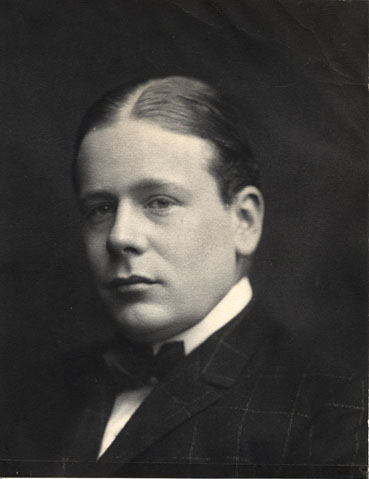
An exception to grand 'friends' were those attractive and rich outsiders, slightly suspect on account of their unseasoned affluence, humble origins or Catholicism, who Harry and his mentors felt, 'might just, rather usefully, be 'put over''.
When he had first taken Mrs. Dahlgren as his fiancée to lunch with the most faithful of his supporters, society's reigning sovereign, Mrs. Astor and her court of heiresses-apparent, Mrs. Stuyvesant Fish, Mrs. Herman Oelrichs, and Mrs. Oliver H. P. Belmont, Harry held his breath fearfully lest they disapprove.
Mrs. Fish, who shared Harry Lehr's mocking sense of humor, was perhaps his best chum.
"Have you seen Cousin Alice?"
he would ask her a few years later, of his wife's bold relation by marriage, Alice Troth Drexel. "Cousin Alice," was viewed by many as a "climber" and a figure of fun, at least behind her back. Immense riches, and her self-important personality, made her too dangerous to criticize openly, particularly as the combination of her absurd pronouncements and lavish entertaining made her especially popular among Europe's royal houses.
Described privately as "looking like a trussed fowl," exclaiming at dinner once how she 'dare not wear her valuable Turquoises against her bare skin as her perspiration was so alkaline', her elaborate households were impeccably run by an impeccable gentleman. Of good birth, William Hude Neilson, who managed "Cousin Alice's" houses and servants, addressed as her social secretary, was widely believed to be her not so secret lover. This was what made Mrs. Fish's response to Harry's innocent seeming inquiry,
"Have you looked under the secretary?"
seem so malicious to most. But to those few aware of Alice Drexel's condescending treatment of Neilson, because his lineage was superior to hers and because he was gay, the bon mot had greater relish still.
Harry need not have been so anxious about his future wife's acceptance. As society's 'court jester', expertly arranging his patrons' parties, choosing the flowers, leading the cotillion, selecting lovely favors, advising them on their attire, jewels and troubles, he had rapidly grown indispensable. Accessing Bessie, they'd been mindful of how this comely, quiet woman's largess would at last make their favorite's life financially trouble-free. So of course they had happily given him their blessing and announced,
"We will make her the fashion. You need have no fear."
Heretofore Wetzel had made Harry's natty suits for free. Yet despite his renown as a trendsetting dandy men's clothes, apparently, had left him indifferent. In his diary he wrote:
"I went to Wetzels and ...did the very best I could to hide how it bored me. Oh, if only I could wear ladies' clothes; all silks and dainty petticoats and laces, how I should love to choose them. I love shopping even for my wife..."
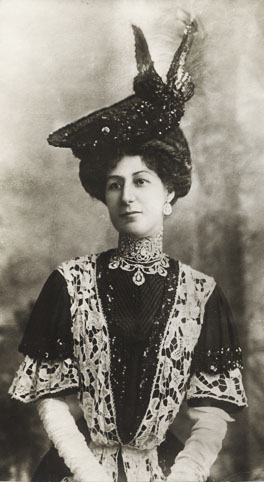
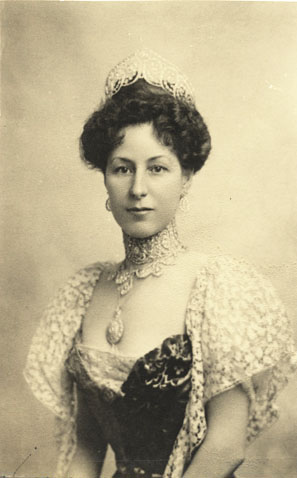
But instead of frocks from Redfern's, Kaskel & Kaskel gave him the latest designs in shirts and underwear, and only asked that he let it be discreetly known where he got them. Ditto for jewelers Black, Starr & Frost, or elegant Sherry's, where he successfully persuaded Mrs. Astor, for the first time in her life to dine in a public restaurant. Now through a simple expedient all this distasteful trading on his unique social position was to be at an end. However, if Harry Lehr's difficult days of living by his wits, as an authoritative promoter of luxury goods, apparel and exclusive places, compensated in clothes, accessories, meals and accommodation was over, for Bessie, greater sorrows were just about to begin. 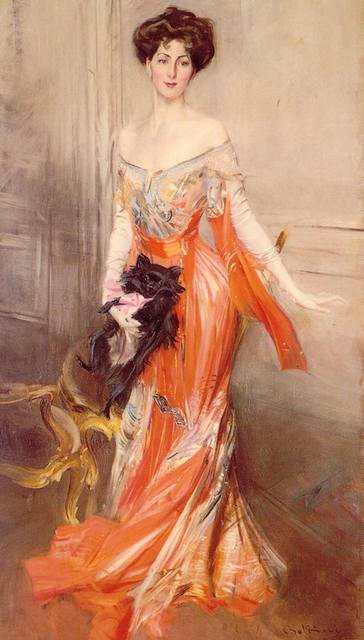 By Giovanni Boldini, 1905
By Giovanni Boldini, 1905
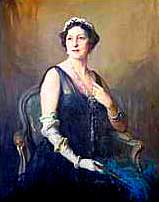 By Philip de Laszlo, ca. 1936
By Philip de Laszlo, ca. 1936
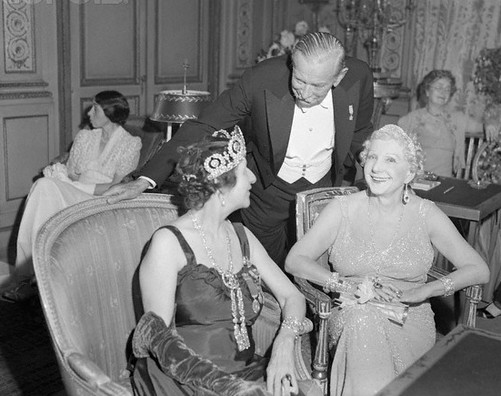 1942
1942
Lady Decies photographed with her friend , and fellow lover
of diamonds, Mrs. George Washington Kavanaugh, at the Red Cross Ball
and the Metropolitan Opera's 60th season.
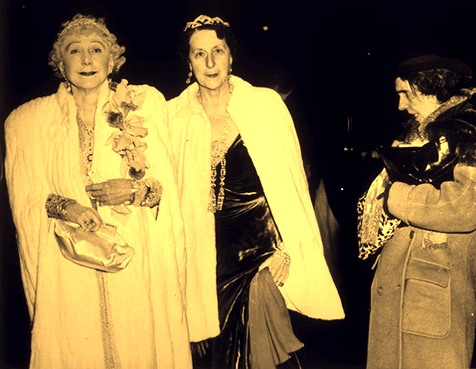 By Weegee 1943
By Weegee 1943
Harry Lehr died following an operation for a brain tumor in 1929. His widow became Baroness Decies on May 25, 1936, by marrying the Irish peer, John Graham Hope de la Poer Beresford, 5th Baron Decies. Widowed for a third time, Lady Decies died in 1944.
Joyfully she had promised her betrothed a princely marriage settlement: $25,000 a year and her agreement to bear their entire household and travel expenses. Eager to re-live the delights of her previous union, she took considerable pains on their wedding night to assure that both she and her new mate would, as she said, "Remember this evening all our lives"
Alluringly gowned in rose colored brocade, adorned by a new diamond brooch, she had ordered the dining room, and her bedroom in their large suite, filled with highly fragrant sheaves of crimson roses. Caviar, quails in aspic, champagne, cigars, she omitted nothing that might contribute to a night of sheer bliss.
After a courtship of perpetual pleasantries, solicitations and endearments, Bessie summoned to Harry's room was callously informed, that he had married her solely for her money, that he did not and never would love her, that she, like all women was indeed physically repulsive to him. Stunned, his bride recoiled, but with scant empathy from the now secure Harry.
"After all," he had stated coolly, "Have you so much to complain of? At least I am being honest with you. How many men in New York, how many among our own friends, if it comes to that, have entered their wives' rooms on their wedding night with exactly my state of mind?"
Robert Gould Shaw, II, the first husband of Nancy Langhorne,(Lady Astor)
depicted as "Little Billie" from George du Maurier's Trilby by R. G. Harper Pennington.
According to Elizabeth Lehr, this painting hung in Harry Lehr's room
"There have been quite a few as it turns out," said the late Stanley Barrows, chuckling over an exquisite glass of pale old sherry in his apartment near Sutton Place a couple of decades ago. "My, my, practically all the married decorators and several of the best architects were 'that way,' to say nothing of some of the handsomest husbands in society. Ogden Codman, I suppose, falls into all three categories? "
If one has seen Clifton Webb  portray a dying, elitist, Elliott Templeton, having procured a coveted ball invitation through trickery, peacefully expire while dictating an imperious R. S.V. P., "Mr. Elliott Templeton regrets that he must decline Her Highness's kind invitation due to a previous engagement with his maker...", then one has observed Ogden Codman too. Codman was offended enough by the Duke and Duchess of Windsor's wish to alter his already 'perfect' villa while foregoing a security deposit, to write "I am sorry that the house of Codman is unable to do business with the house of Windsor!" Similarly, resignedly taking to his bed, he lived on chocolates during the Second World War, when Nazi officers requisitioned his chateau.
portray a dying, elitist, Elliott Templeton, having procured a coveted ball invitation through trickery, peacefully expire while dictating an imperious R. S.V. P., "Mr. Elliott Templeton regrets that he must decline Her Highness's kind invitation due to a previous engagement with his maker...", then one has observed Ogden Codman too. Codman was offended enough by the Duke and Duchess of Windsor's wish to alter his already 'perfect' villa while foregoing a security deposit, to write "I am sorry that the house of Codman is unable to do business with the house of Windsor!" Similarly, resignedly taking to his bed, he lived on chocolates during the Second World War, when Nazi officers requisitioned his chateau.
More discerning and intelligent than most of his fellows, as much of a wag and a dandy as Harry Lehr, even during his far less aware era, Codman must have been viewed by many with a certain circumspection. His intended, six years older than the gifted architect, Leila Griswold Webb, the widow of a railroad magnate, had 2 sons.
One journalist audacious enough to register astonishment at this unforeseen match said of the 41-year bridegroom,
"It had been supposed that he would die a bachelor..."

In all events, so obliging and supportive was the socially prominent new Mrs. Ogden Codman, that within six years she had died, leaving her widower husband, financially and otherwise, utterly independent.
Sharing such a fevered passion for the superior art and atmosphere of Europe, Codman and his devoted friend Edith Wharton 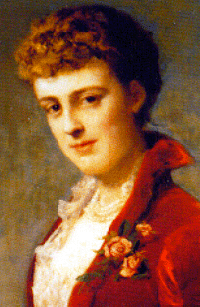 were by far more truthfully a kindred pair. Together, they enjoyed little better than commiserating on the "dullness" of nearly everyone else whom they knew at Newport and in New York. Stereotyping aside, their eventual falling-out, from hindsight, seems inevitable.
were by far more truthfully a kindred pair. Together, they enjoyed little better than commiserating on the "dullness" of nearly everyone else whom they knew at Newport and in New York. Stereotyping aside, their eventual falling-out, from hindsight, seems inevitable.
Yet it had been Wharton who was instrumental to his great success. She had introduced Codman to Cornelius Vanderbilt II, who hired him in 1894 to design the bedroom floors of his new Newport cottage. The Breakers was decorated by Codman, assisted by a brilliant draftsman, previously employed by Richard Morris Hunt, named Emery Roth, who was an immigrant from Hungary and Jewish. Their décor reflected the neo-classical style of eighteenth century France and Italy. This early high-profile commission led to numerous successes, until armed with his ample inheritance, Codman created a house of his own on the Côte d'Azur to rival anything that Newport might offer.
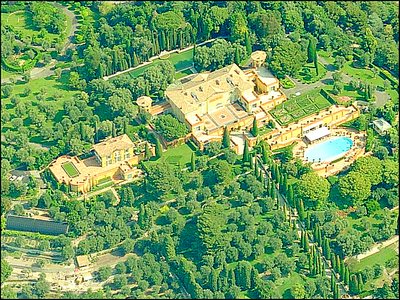


La Leopolda rises above the sea like a dream, as anyone who has seen Moira Shearer mount its heroic garden stair in The Red Shoes will attest. Contemplating its grandeur, it comes as little surprise to learn that Codman consumed much of his own fortune and, illegally, much of his stepson's inheritances as well, to realize such loveliness. Wouldn't Codman have been proud to know that today his house is billed as the most costly in the world, having recently sold for 500,000,000 Euros to a mysterious Russian!
